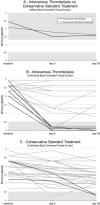Intravenous thrombolysis in acute central retinal artery occlusion - A prospective interventional case series
- PMID: 29813111
- PMCID: PMC5973600
- DOI: 10.1371/journal.pone.0198114
Intravenous thrombolysis in acute central retinal artery occlusion - A prospective interventional case series
Abstract
Background: No evidence-based therapy exists for non-arteritic central retinal artery occlusion (NA-CRAO). Retinal ischemic tolerance is low; irreversible damage occurs within four hours of experimental NA-CRAO. In previous randomized trials evaluating intra-arterial or intravenous thrombolysis (IVT) in NA-CRAO, only one patient was treated this early. In December 2013, the Departments of Neurology & Stroke and Ophthalmology at University Hospital Tuebingen, Germany, decided to treat patients using IVT within 4.5 hours of NA-CRAO, the therapeutic window established for ischemic stroke.
Materials and methods: Consecutive NA-CRAO patients with severe visual loss received IVT after exclusion of intracranial hemorrhage. Follow-up was conducted at day 5 (d5) and day 30 (d30). Visual outcomes were compared to the conservative standard treatment (CST) arm of the EAGLE-trial.
Results: Until August 2016, 20 patients received IVT within 4.5 hours after NA-CRAO with a median onset-to-treatment time of 210 minutes (IQR 120-240). Visual acuity improved from baseline mean logarithm of the minimum angle of resolution 2.46±0.33 (SD) (light perception) to 1.52±1.09 (Snellen equivalent: 6/200) at d5 (p = 0.002) and 1.60±1.08 (Snellen equivalent: 6/240) at d30. Compared to the EAGLE CST-arm, functional recovery to reading ability occurred more frequently after IVT: 6/20 (30%) versus 1/39 (3%) at d5 (p = 0.005) and at d30 5/20 (25%) versus 2/37 (5%) (p = 0.045). Two patients experienced serious adverse events (one angioedema and one bleeding from an abdominal aortic aneurysm) but recovered without sequelae.
Conclusions: IVT within 4.5 hours after symptom onset may represent an effective treatment of NA-CRAO. Randomized trials are warranted to evaluate efficacy and safety of early IVT in acute NA-CRAO.
Conflict of interest statement
Sven Poli received speaker’s honoraria and reimbursement for congress travels from Boehringer-Ingelheim. All other authors have nothing to disclose. This does not alter our adherence to PLOS ONE policies on sharing data and materials.
Figures



References
-
- Biousse V, Calvetti O, Bruce BB, Newman NJ. Thrombolysis for central retinal artery occlusion. . 2007;27:215–230 doi: 10.1097/WNO.0b013e31814b1f66 - DOI - PubMed
-
- Olsen TW, Pulido JS, Folk JC, Hyman L, Flaxel CJ, Adelman RA. Retinal and ophthalmic artery occlusions preferred practice pattern(r). . 2017; 37(7):1345–1351 - PubMed
-
- Hayreh SS, Zimmerman MB. Central retinal artery occlusion: Visual outcome. . 2005;140:376–391 doi: 10.1016/j.ajo.2005.03.038 - DOI - PubMed
-
- McLeod D, Beatty S. Evidence for an enduring ischaemic penumbra following central retinal artery occlusion, with implications for fibrinolytic therapy. . 2015;49:82–119 doi: 10.1016/j.preteyeres.2015.06.001 - DOI - PubMed
-
- Hayreh SS, Zimmerman MB, Kimura A, Sanon A. Central retinal artery occlusion. Retinal survival time. . 2004;78:723–736 - PubMed
Publication types
MeSH terms
LinkOut - more resources
Full Text Sources
Other Literature Sources

